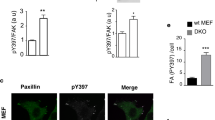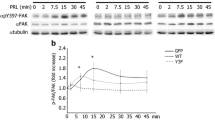Abstract
The effects of pituitary adenylate cyclase-activating polypeptide (PACAP) on tyrosine phosphorylation of focal adhesion kinase (FAK) and paxillin were investigated using lung cancer cells. Addition of PACAP-27 or PACAP-38 but not vasoactive intestinal peptide to NCI-H838 or NCI-H1299 human lung cancer cells significantly increased the tyrosine phosphorylation of FAK or paxillin. The increase in FAK or paxillin tyrosine phosphorylation caused by addition of PACAP-27 to NCI-H838 cells was inhibited by PACAP(6–38), a PAC1-receptor (R) antagonist. The increase in FAK or paxillin tyrosine phosphorylation caused by 100 nM PACAP-27 was maximal 2 min after addition to NCI-H838 cells. The effects of PACAP at stimulating FAK and paxillin tyrosine phosphorylation were reversed by cytochalasin D and genistein which inhibit actin polymerization and tyrosine kinase activity, respectively. The effects of PACAP at stimulating FAK and paxillin tyrosine phosphorylation were reversed by U-73122 but not H89 which inhibit phospholipase C and protein kinase A, respectively. The results show that PAC1-R regulates FAK and paxillin tyrosine phosphorylation in lung cancer cells as a result of increased phosphatidylinositol turnover but not adenylyl cylase stimulation.




Similar content being viewed by others
Abbreviations
- PACAP:
-
Pituitary adenylate cyclase-activating polypeptide
- FAK:
-
Focal adhesion kinase
- R:
-
Receptor
- SCLC:
-
Small cell lung cancer
- NSCLC:
-
Non-SCLC
- VIP:
-
Vasoactive intestinal peptide
- GRP:
-
Gastrin-releasing peptide
- Ca2+ :
-
Calcium
- GPCR:
-
G-protein-coupled receptor
- pY:
-
Phosphotyrosine
References
Akiyama T, Isidia J, Nakagawa H, Ogawara S, Vatanabe N, Itoh M, Shibuya M (1987) Genistein, a specific inhibitor of tyrosine-specific protein kinase. Biol Chem 262:5592–5595
Arimura A (1992) Pituitary adenylate cyclase activating polypeptide (PACAP): discovery and current status of research. Regul Pept 37:287–303
Bellis SL, Perotta JA, Curtis MS, Turner CE (1997) Adhesion of fibroblasts to fibronectin stimulates both serine and tyrosine phosphorylation of paxillin. Biochem J 325:375–381
Bergan R, Kyle E, Nguyen P, Trepel J, Neckers L (1996) Genistein-stimulated adherence of prostate cancer cells is associated with the binding of focal adhesion kinase to beta-1-integrin. Clin Exp Metastasis 14:389–398
Burridge K, Turner CE, Romer LH (1992) Tyrosine phosphorylation of paxillin and p125FAK accompanies cell adhesion to extracellular matrix: a role in cytoskeletal assembly. J Cell Biol 119:893–903
Buscail L, Cambillau C, Seva C, Scemama JL, DeNeef P, Robberecht P, Christophe J, Susini C, Vaysse N (1992) Stimulation of rat pancreatic tumoral AR4-2J cell proliferation by pituitary adenylate cyclase-activating polypeptide. Gastroenterology 103(3):1002–1008
Cary LS, Han DC, Poite TR, Hanks SK, Fuan JL (1998) Identification of p130Cas as a mediator of focal adhesion kinase-prompted cell migration. J Cell Biol 140:211–221
Chrzanowski-Wodnick M, Burridge K (1996) Rho-stimulated contractility drives the formation of stress fibers and focal adhesions. J Cell Biol 133:1403–1415
Cooper JA (1987) Effects of cytochalasin and phalloidin on actin. J Cell Biol 105:1473–1478
Draoui M, Hida T, Birrer M, Zia F, Moody TW (1996) PACAP stimulates c-fos mRNAs in small cell lung cancer cells. Life Sci 59(4):307–313
El Zein N, Corazza F, Sariban E (2006) The neuropeptide pituitary adenylate cyclase activating protein is a physiological activator of human monocytes. Cell Signal 18:162–173
Germano PM, Lieu SN, Xue J, Cooke HJ, Christoff GL, Ly Y, Pisegna JR (2009) PACAP induces signaling and stimulation of 5-hydroxytryptamine release and growth in neuroendocrine tumor cells. J Mol Neurosci 39(3):391–401
Hanks SK, Calab MD, Harper MC, Patel SK (1992) Focal adhesion protein-tyrosine phosphorylation in response to cell attachment to fibronectin. Proc Natl Acad Sci USA 89:8487–8491
Hildebrand JD, Taylor JM, Parsons JT (1996) An SH3 domain containing GTPase-activating protein for Rho and Cdc42 associates with focal adhesion kinase. Mol Cell Biol 16:3169–3178
Ishihara T, Shigemoto R, Mori K, Takahashi K, Nagata S (1992) Functional expression and tissue distribuiton of a novel receptor for vasoactive intestinal polypeptide. Neuron 8:811–819
Jones RJ, Brunton VG, Frame MC (2000) Adhesion-linked kinases in cancer: emphasis on Src, focal adhesion kinase and PI 3-kinase. Eur J Cancer 36:1595–1606
Korman LY, Carney DN, Citron ML, Moody TW (1986) Secretin/VIP stimulated secretion of bombesin-like peptides from human small cell lung cancer. Cancer Res 46:1214–1218
Lee M, Jensen RT, Bepler G, Korman LY, Moody TW (1990) Vasoactive intestinal polypeptide binds with high affinity to non-small cell lung cancer cells and elevates cAMP levels. Peptides 11:1205–1210
Lee FS, Rajagopal R, Kim AH, Chang PC, Shao MV (2002) Activation of Trk neurotropin receptor signaling by pituitary adenylate cyclase-activating polypeptide. J Biol Chem 277:9096–9102
Leyton J, Coelho T, Coy DH, Jakowlew S, Birrer MJ, Wank S, Moody TW (1999) PACAP(6–38) inhibits the growth of prostate cancer cell lines. Cancer Lett 125:131–139
Leyton J, Garcia L, Jensen RT, Moody TW (2001) Bombesin and gastrin releasing peptide increase tyrosine phosphorylation of focal adhesion kinase and paxillin in non-small cell lung cancer cells. Cancer Lett 162:87–95
Leyton J, Garcia-Marin L, Jensen RT, Moody TW (2002) Neurotensin causes tyrosine phosphorylation of focal adhesion kinase in non-small cell lung cancer cells. Eur J Pharmacol 442:179–186
Lutz EM, Sheward WJ, West KM, Morrow JA, Harmar AJ (1993) The VIP2 receptor molecular characterization of a cDNA encoding a novel receptor for vasoactive intestinal peptide. FEBS Lett 334:3–8
Macdonald DS, Weerapura M, Beazely MA, Martin L, Czerwinski W, Roder JC, Orser BA, MacDonald JF (2005) Modulation of NMDA receptor by pituitary adenylate cyclase activating peptide in CA1 neurons requires Gαq, protein kinase C and activation of Src. J Neuroscience 25:11374–11384
May V, Lutz E, MacKenzie C, Schutz K, Dozark K, Braas KM (2010) Pituitary adenylate cyclase-activating polypeptide (PACAP)/PAC1HOP1 receptor activation coordinates multiple neurotrophic signaling pathways. J Biol Chem 285:9749–9761
Moody TW, Jensen RT (2006) VIP and PACAP as autocrine growth factors in breast and lung cancer. “Handbook of Biologically active peptides,” Kastin, A. (ed), Elsevier Press, 493–498
Moody TW, Pert CB, Gazdar AF, Carney DN, Minna JD (1981) High levels of intracellular bombesin characterize human small-cell lung carcinoma. Science 214:1246–1248
Moody TW, Zia F, Draoui M, Brenneman DE, Fridkin M, Davidson A, Gozes I (1993a) A novel VIP antagonist inhibits non-small cell lung cancer growth. Proc Natl Acad Sci USA 90:4345–4349
Moody TW, Zia F, Makheja A (1993b) Pituitary adenylate cyclase activating polypeptide receptors are present on small cell lung cancer cells. Peptides 14(2):241–246
Moody TW, Zia F, Bitar K, Coy DH (1994) In: Rosselin G (ed) PACAP(6–38) is a PACAP type I receptor antagonist on small cell lung cancer cells, VIP, PACAP and related regulatory peptides: from molecular biology to clinical applications. World Scientific Publishing Co, Singapore, pp 527–534
Moody TW, Czerwinski G, Tarasova NI, Michejda CJ (2002a) VIP-ellipticine derivatives inhibit the growth of breast cancer cells. Life Sci 19:1005–1014
Moody TW, Leyton J, Casibang M, Pisegna J, Jensen RT (2002b) PACAP-27 tyrosine phosphorylates mitogen activated protein kinase and increases VEGF mRNAs in human lung cancer cells. Regul Pept 109:135–140
Moody TW, Chan D, Fahrenkrug J, Jensen RT (2003a) Neuropeptides as autocrine growth factors in cancer cells. Curr Pharm Des 9:495–509
Moody TW, Hill JM, Jensen RT (2003b) VIP as a trophic factor in the CNS and cancer cells. Peptides 24:163–177
Obara Y, Horgan AM, Stork PJS (2007) The requirement of Ras and Rap1 for the activation of ERKs by cAMP, PACAP and KCl in cerebellar granule cells. J Neurochem 101:470–482
Ocak S, Yamashita H, Udyavar AR, Miller AN, Gonzalez AL, Zou Y, Jiang A, Yi Y, Shyr Y, Estrada L, Quaranta V, Massion PP (2010) DNA copy number aberrations in small-cell lung cancer reveal activation of the focal adhesion pathway. Oncogene 29:6331–6342
Pisegna J, Wank SA (1993) Molecular cloning and functional expression of the pituitary adenylate cyclase activating polypeptide type I receptor. Proc Natl Acad Sci USA 90:6345–6349
Pisegna JR, Wank SA (1996) Cloning and characterization of the signal transduction of four splice variants of the human pituitary adenylate cyclase activating polypeptide receptor. Evidence for dual coupling to adenylate cyclase and phospholipase C. J Biol Chem 271:17267–17274
Reubi JC, Laderach U, Waser B, Gebbers JD, Robberecht P, Laissue JA (2000) Vasoactive intestinal peptide/pituitary adenylate cyclase activating polypeptide receptor subtypes in human tumors and their tisssues of origin. Cancer Res 60:3105–3112
Roberts WG, Ung El Whalen P, Cooper B, Hulford C, Autry C (2008) Antitumor activity and pharmacology of a selective focal adhesion kinase inhibitor. Cancer Res 68:1935–1944
Rozengurt E (1991) Neuropeptides as cellular growth-factors: role of multiple signaling pathways. Eur J Clin Invest 21:123–134
Schaller MD, Borgman CA, Cobb BS, Vaines RR, Reynolds AB, Parsons JT (1992) P125FAK, a structurally distinctive protein-tyrosine kinase associated with focal adhesions. Proc Natl Acad Sci USA 89:192–196
Schaller MD, Otey CA, Hildebrand JD, Parsons JT (1995) Focal adhesion kinase and paxillin bind to peptides mimicking beta integrin cytoplasmic domains. J Cell Biol 130:1181–1187
Sheddon K, Taylor JM, Enkemann SA (2008) Gene expression-based survival prediction in lung adenocarcinoma: a multi-site blinded validation study. Nat Med 14:822–827
Sherwood NM, Krueckl SL, McRory JE (2000) The origin and function of the pituitary adenylate cyclase-activating polypeptide have different tissue distributions. Endocrinology 128:3055–3065
Spengler D, Waeber C, Pantaloni C, Holsboer F, Bockaert J, Seeburg PH, Journot L (1993) Differential signal transduction by five splice variants of the PACAP receptor. Nature 365:170–175
Taniguchi T, Takaishi K, Murayama T, Ito M, Iwata N, Chihara K, Sasaki T, Takai Y, Matsui T (1996) Cholecystokinin-B/gastrin receptors mediate rapid formation of actin stress fibers. Oncogene 12:1357–1360
Vaudry D, Falluel-Morel A, Bourgault S, Basille M, Burel D, Wurtz O, Fournier A, Chow BKC, Hashimoto H, Galas L, Vaudry H (2009) Pituitary adenylate cyclase-activating polypeptide and its receptors: 20 years after the discovery. Pharmacol Rev 61:283–357
Wu DW, Cheng YW, Wang J, Chen CY, Lee H (2010) Paxillin predicts survival and relapse in non-small cell lung cancer by microRNA-218 targeting. Cancer Res 70:10392–10401
Xu L, Owens LV, Sturge GC, Yang X, Liu ET, Craven RJ, Chance WG (1996) Attenuation of focal adhesion kinase induces apoptosis in tumor cells. Cell Growth Differ 7:413–418
Zia F, Fagarasan M, Bitar K, Coy DH, Pisegna J, Wank S, Moody TW (1995) PACAP receptors regulate the growth of non-small cell lung cancer cells. Cancer Res 55:4886–4891
Acknowledgments
This research is supported in part by intramural funds of the NCI and NIDDK of NIH.
Author information
Authors and Affiliations
Corresponding author
Rights and permissions
About this article
Cite this article
Moody, T.W., Leyton, J. & Jensen, R.T. Pituitary Adenylate Cyclase-Activating Polypeptide Causes Increased Tyrosine Phosphorylation of Focal Adhesion Kinase and Paxillin. J Mol Neurosci 46, 68–74 (2012). https://doi.org/10.1007/s12031-011-9639-7
Received:
Accepted:
Published:
Issue Date:
DOI: https://doi.org/10.1007/s12031-011-9639-7




